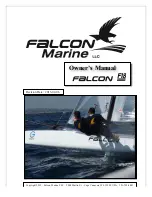
Section 04
ENGINE (2-STROKE)
Subsection 02
(LEAK TEST)
SMR2003-007_04_02A.FM
04-02-1
LEAK TEST
0
GENERAL
A Sea-Doo Engine Leak Test Kit (P/N 295 500 352)
and Supplementary Engine Leak Test Kit (P/N 295
500 780) are available to help diagnose engine
problems such as engine seizure, poor perfor-
mance, oil leakage, etc.
Before disassembling any components of the en-
gine, it is important to perform a leakage test to
determine which part is defective.
It is also very important after servicing the engine,
even for a complete engine rebuilt, to perform an-
other leakage test; at this stage, it may avoid fur-
ther engine problems and minimizing the risk of
having to remove and reinstall the engine again.
Static bench testing is the most effective way to
conduct a leakage test. Inboard testing does not
allow complete access to, and observation of all
engine surfaces and should be avoided whenever
possible.
On the
717 engine
, cylinders can not be verified
individually due to leakage from one cylinder to an-
other through a common intake manifold.
When installing hoses of the Engine Leak Test Kit
or Supplementary Engine Leak Test Kit, use the
collars provided in the kit to ensure a proper seal-
ing.
When pressurizing the engine, first confirm that
the components of the Engine Leak Test Kit or
Supplementary Engine Leak Test Kit are not leak-
ing by spraying a solution of soapy water on all
hoses, connections, fittings, plates, etc. If there is
a leak, bubbles will indicate leak location.
Three areas of the engine will be tested in se-
quence as per the diagnostic flow chart (see the
end of this subsection).
1. Engine Cooling System.
2. Bottom End and Top End.
3. Rotary Valve Shaft (
except DI engine
).
NOTE:
If a leak is found, it is important to continue
testing as there is the possibility of having more
than one leak. Continue pumping to compensate
for the air lost to find another leak.
PREPARATION
Verify fuel system for leaks.
Disconnect battery BLACK negative cable.
Disconnect battery RED positive cable.
TESTING PROCEDURE
Engine Cooling System
Remove the tuned pipe. Refer to EXHAUST SYS-
TEM.
Remove the exhaust manifold gasket and ensure
the surface is clean.
Disconnect engine cooling hoses.
Install the appropriate exhaust manifold plate from
the Engine Leak Test Kit (P/N 295 500 352) or Sup-
plementary Engine Leak Test Kit (P/N 295 500 780).
Tighten plate using fasteners provided in the kit.
NOTE:
Do not torque plate excessively.
Install a hose pincher on engine drain hose.
WARNING
If any fuel leak is found, do not start the en-
gine. Correct the leak and wipe off any fuel
spillage. Do not use electric powered tools
unless fuel system has passed pressure test.
WARNING
Always disconnect battery cables in the speci-
fied order, BLACK negative cable first.
www.SeaDooManuals.net
Summary of Contents for 2003 GTI LE RFI
Page 1: ...www SeaDooManuals net ...
Page 767: ...NOTE www SeaDooManuals net ...
Page 768: ...NOTE www SeaDooManuals net ...
Page 769: ...F00Z0D 2003 GTI MODEL WARNING www SeaDooManuals net ...
Page 770: ...F00Z0C 2003 GTI LE MODEL WARNING www SeaDooManuals net ...
Page 771: ...F00Z0E 2003 GTI LE RFI MODEL WARNING www SeaDooManuals net ...
Page 772: ...F00Z0J 2003 RX DI MODEL WARNING www SeaDooManuals net ...
Page 773: ...F00Z0I 2003 GTX DI MODEL WARNING www SeaDooManuals net ...
Page 774: ...F00Z0K 2003 XP DI MODEL WARNING www SeaDooManuals net ...
Page 775: ...F00Z0F 2003 GTX 4 TEC MODEL WARNING www SeaDooManuals net ...
Page 776: ...F00Z0G 2003 GTX 4 TEC MODEL WITH AUXILIARY DESS MODULE WARNING www SeaDooManuals net ...
Page 777: ...F00Z0B 2003 GTX 4 TEC AND GTX 4 TEC SUPERCHARGED MODELS WARNING www SeaDooManuals net ...
Page 779: ...www SeaDooManuals net ...
















































